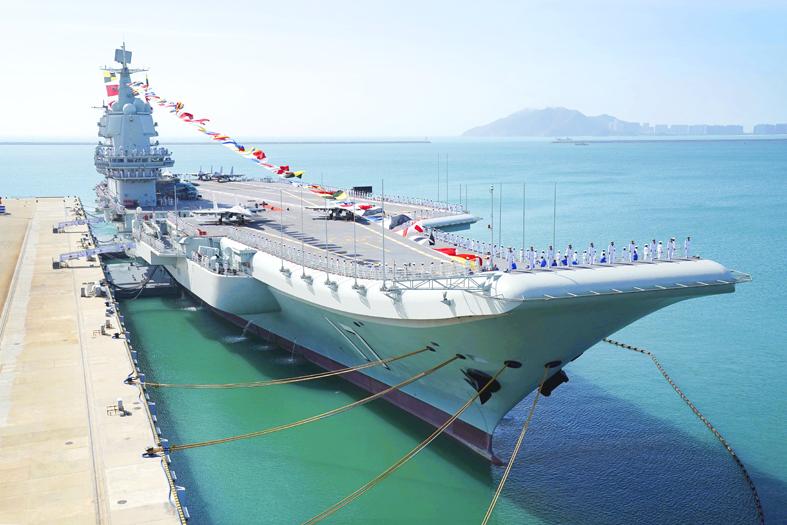China yesterday sailed an aircraft carrier through the Taiwan Strait, shadowed by a US destroyer, a source with direct knowledge of the matter said, just hours before the Chinese and US presidents were due to talk.
The source, who was not authorized to speak to the media and spoke on condition of anonymity, told Reuters that the carrier Shandong sailed close to Kinmen County.
“Around 10:30am the CV-17 appeared around 30 nautical miles to the southwest of Kinmen, and was photographed by a passenger on a civilian flight,” the source said, referring to the Shandong’s official service number.

Photo: AP
The USS Ralph Johnson, an Arleigh Burke-class guided missile destroyer, shadowed the carrier, which did not have aircraft on its deck and sailed north through the Strait, the source added.
Taiwan also sent warships to monitor the situation, the source said.
The Ministry of National Defense declined to comment, but said its forces always keep close tabs on Chinese activity in the Strait and “respond in accordance with standard procedures.”
US Navy spokesman Mark Langford said the Ralph Johnson “conducted a routine Taiwan Strait transit March 17 local time through international waters in accordance with international law.”
He did not elaborate.
Chinese Ministry of Foreign Affairs spokesman Zhao Lijian (趙立堅) referred questions to the Chinese Ministry of National Defense, which did not immediately respond to a request for comment, but said the Shandong has a “routine training schedule.”
“We should not associate this with the communication between the heads of state of China and the United States. You may think it is too sensitive. What is sensitive is you, not the Taiwan Strait,” Zhao told reporters in Beijing.
The sailing happened about 12 hours before US President Joe Biden was due to speak to Chinese President Xi Jinping (習近平).
The source described the timing of the Shandong’s movement so close to that call as “provocative,” and said it was unusual that the vessel sailed during daylight hours, with previous missions happening at night.
The Chinese navy in April last year said a carrier group, led by the Liaoning, the country’s first aircraft carrier put into active service, was carrying out routine drills near Taiwan.
The Shandong is China’s newest aircraft carrier, commissioned in 2019.
In December 2019, shortly before presidential and legislative elections in Taiwan, the Shandong sailed through the Strait, a move Taiwan condemned as attempted intimidation.
The air force scrambles aircraft almost daily to ward off Chinese warplanes flying into Taiwan’s air defense identification zone, mostly in the southwestern part of the Strait near the South China Sea.
Taiwan calls this “gray zone” warfare activity, designed to test its responses and wear out its air force.

WAITING GAME: The US has so far only offered a ‘best rate tariff,’ which officials assume is about 15 percent, the same as Japan, a person familiar with the matter said Taiwan and the US have completed “technical consultations” regarding tariffs and a finalized rate is expected to be released soon, Executive Yuan spokeswoman Michelle Lee (李慧芝) told a news conference yesterday, as a 90-day pause on US President Donald Trump’s “reciprocal” tariffs is set to expire today. The two countries have reached a “certain degree of consensus” on issues such as tariffs, nontariff trade barriers, trade facilitation, supply chain resilience and economic security, Lee said. They also discussed opportunities for cooperation, investment and procurement, she said. A joint statement is still being negotiated and would be released once the US government has made

NEW GEAR: On top of the new Tien Kung IV air defense missiles, the military is expected to place orders for a new combat vehicle next year for delivery in 2028 Mass production of Tien Kung IV (Sky Bow IV) missiles is expected to start next year, with plans to order 122 pods, the Ministry of National Defense’s (MND) latest list of regulated military material showed. The document said that the armed forces would obtain 46 pods of the air defense missiles next year and 76 pods the year after that. The Tien Kung IV is designed to intercept cruise missiles and ballistic missiles to an altitude of 70km, compared with the 60km maximum altitude achieved by the Missile Segment Enhancement variant of PAC-3 systems. A defense source said yesterday that the number of

‘CRUDE’: The potential countermeasure is in response to South Africa renaming Taiwan’s representative offices and the insistence that it move out of Pretoria Taiwan is considering banning exports of semiconductors to South Africa after the latter unilaterally downgraded and changed the names of Taiwan’s two representative offices, the Ministry of Foreign Affairs (MOFA) said yesterday. On Monday last week, the South African Department of International Relations and Cooperation unilaterally released a statement saying that, as of April 1, the Taipei Liaison Offices in Pretoria and Cape Town had been renamed the “Taipei Commercial Office in Johannesburg” and the “Taipei Commercial Office in Cape Town.” Citing UN General Assembly Resolution 2758, it said that South Africa “recognizes the People’s Republic of China (PRC) as the sole

Taiwanese exports to the US are to be subject to a 20 percent tariff starting on Thursday next week, according to an executive order signed by US President Donald Trump yesterday. The 20 percent levy was the same as the tariffs imposed on Vietnam, Sri Lanka and Bangladesh by Trump. It was higher than the tariffs imposed on Japan, South Korea and the EU (15 percent), as well as those on the Philippines (19 percent). A Taiwan official with knowledge of the matter said it is a "phased" tariff rate, and negotiations would continue. "Once negotiations conclude, Taiwan will obtain a better